Asus ROG Zephyrus G14 2022 (R9, 6800S), 2021 (R9, 3060), 2020 (R9, 2060) models compared
Over the years, I’ve reviewed multiple variants of the popular Asus ROG Zephyrus G14 series of portable performance laptops, and I wanted to put up together a comparison of the generations available so far, so you’ll better understand the main differences between them.
So, in this article we’re going to look at the original G14 from 2020 (Ryzen 9 4000 + RTX 2060), the hardware bump G14 from 2021 (Ryzen 9 5000 + RTX 3060), and the revamped 2022 G14 models built entirely on AMD hardware now.
In a few words, the 2021 G14 was mostly a hardware update of the original design from 2020, both 14-inch laptops built on AMD + Nvidia hardware, while the 2022 generation is a brand new design, with 16:10 screens, updated looks and ergonomics, and a completely changed hardware package and cooling solution. As a result, the 2022 G14 is also more expensive than the previous models were at launch.
With these in mind, I think you should be aware of the multiple differences between these models in order to make a well-documented purchase decision, as even the older G14 are still available in stores in most regions. And that’s the purpose of this article.
Specs as compared
Here’s the specs sheet of the 2022, 2021, and 2022 Zephyrus G14s, and we’ll further touch on the important aspects down below.
Follow this link for updated prices and availability, or this one if you’re in the US and looking for the BestBuy offer, which seem to have some solid exclusive deals for the G14 series these days.
2022 ASUS ROG Zephyrus G14 GA402R – review and review
2021 ASUS ROG Zephyrus G14 GA401Q – review
2020 ASUS ROG Zephyrus G14 GA40IV – review
Screen
14 inch, 16:10, non-touch, matte, several panel options:
QHD+ 120Hz 3ms response, 500-nits, 100% DCI-P3, Pantone validated
FHD+ 144Hz 3ms response, 450-nits, 100% sRGB, Pantone validated
14 inch, 16:9, non-touch, matte, 3 panel options:
QHD 120Hz, 350-nits, 100% DCI-P3, Pantone validated
FHD 144Hz, 350-nits, 100% sRGB, Pantone validated
FHD 60Hz response, ~70% sRGB
14 inch, 16:9, non-touch, matte, 3 panel options:
QHD 60Hz, 350-nits, 100% sRGB
FHD 120Hz, 300-nits, 100% sRGB
FHD 60Hz response, ~70% sRGB
Processor
up to AMD Rembrandt Ryzen 9 6900HS, 8C/16T
up to AMD Cezanne Ryzen 9 5900HS, 8C/16T
up to AMD Renoir Ryzen 9 4900HS, 8C/16T
Video
Radeon 680M and up to AMD Radeon RX 6800S (up to 105W with Smartshift)
with MUX and Adaptive Sync
Radeon Vega and up to Nvidia RTX 3060 Laptop (up to 80W with Dynamic Boost)
with Adaptive Sync, without MUX
Radeon Vega and up to Nvidia RTX 2060 Laptop (up to 65W with Dynamic Boost)
with Adaptive Sync, without MUX
Memory
up to 48 GB DDR5-4800 (8/16 GB soldered, 1x DIMM)
up to 48 GB DDR4-3200 (8/16 GB soldered, 1x DIMM)
up to 48 GB DDR4-3200 (8/16 GB soldered, 1x DIMM)
Storage
1x M.2 PCIe 4.0 SSD
1x M.2 PCIe 3.0 x4 SSD
1x M.2 PCIe 3.0 x4 SSD
Connectivity
WiFi 6E (Mediatek) 2×2 with Bluetooth 5.2
WiFi 6 (Intel AX201) 2×2 with Bluetooth 5.1
WiFi 6 (Intel AX200) 2×2 with Bluetooth 5.0
Ports
left: DC-in, HDMI 2.0b, 1x USB-C gen 2 with data, DP and charging, audio jack
right: 2x USB-A 3.2, 1x USB-C gen2 with data& DP, UHS-II micro SD card reader
left: DC-in, HDMI 2.0b, 1x USB-C gen 2 with data, DP and charging, audio jack, Lock
right: 2x USB-A 3.2, 1x USB-C gen2 data only
left: DC-in, HDMI 2.0b, 1x USB-C gen 2 with data, DP and charging, audio jack, Lock
right: 2x USB-A 3.2, 1x USB-C gen2 data only
Battery
76 Wh, 240 W power adapter, USB-C charging up to 100W
76 Wh, 180 W power adapter, USB-C charging up to 100W
76 Wh, 180 W power adapter, USB-C charging up to 65W
Size
312 mm or 12.28” (w) x 227 mm or 8.93 (d) x 18.5-19.5 mm or .73-.78” (h)
324 mm or 12.75” (w) x 222 mm or 8.74” (d) x 19.9 mm or .78” (h)
324 mm or 12.75” (w) x 222 mm or 8.74” (d) x 19.9 mm or .78” (h)
Weight
1.7 kg (3.75 lbs) with Anime Matrix display,
1.65 kg (3.66 lbs) without Anime Matrix display,
.59 kg (1.3 lbs) power brick and cables, US version
1.7 kg (3.75 lbs) with Anime Matrix display,
1.64 kg (3.65 lbs) without Anime Matrix display,
.59 kg (1.3 lbs) power brick and cables, EU version
1.7 kg (3.75 lbs) with Anime Matrix display,
1.64 kg (3.65 lbs) without Anime Matrix display,
.59 kg (1.3 lbs) power brick and cables, EU version
Extras
single-zone RGB keyboard, HD webcam with IR, quad speakers, optional updated Anime Matrix Display,
updated cooling module with vapor chamber and liquid metal compound,
available in all-white or gray
white backlit keyboard, no webcam, quad speakers, finger-sensor in the power button, optional Anime Matrix Display,
available in silver/white or gray
white backlit keyboard, no webcam, quad speakers, finger-sensor in the power button, optional Anime Matrix Display,
available in silver/white or gray
Update: If interested, here are our thoughts on the 2023 Asus ROG Zephyrus G14 update. We’ll add the 2023 model to the comparison once we get to properly test it.
Design and ergonomics
I’m using the 2022 and the 2021 G14s for illustration purposes here, as the 2020 and 2021 models are pretty much identical designs, so my comments on the 2021 generation would also apply to the original model from 2020.
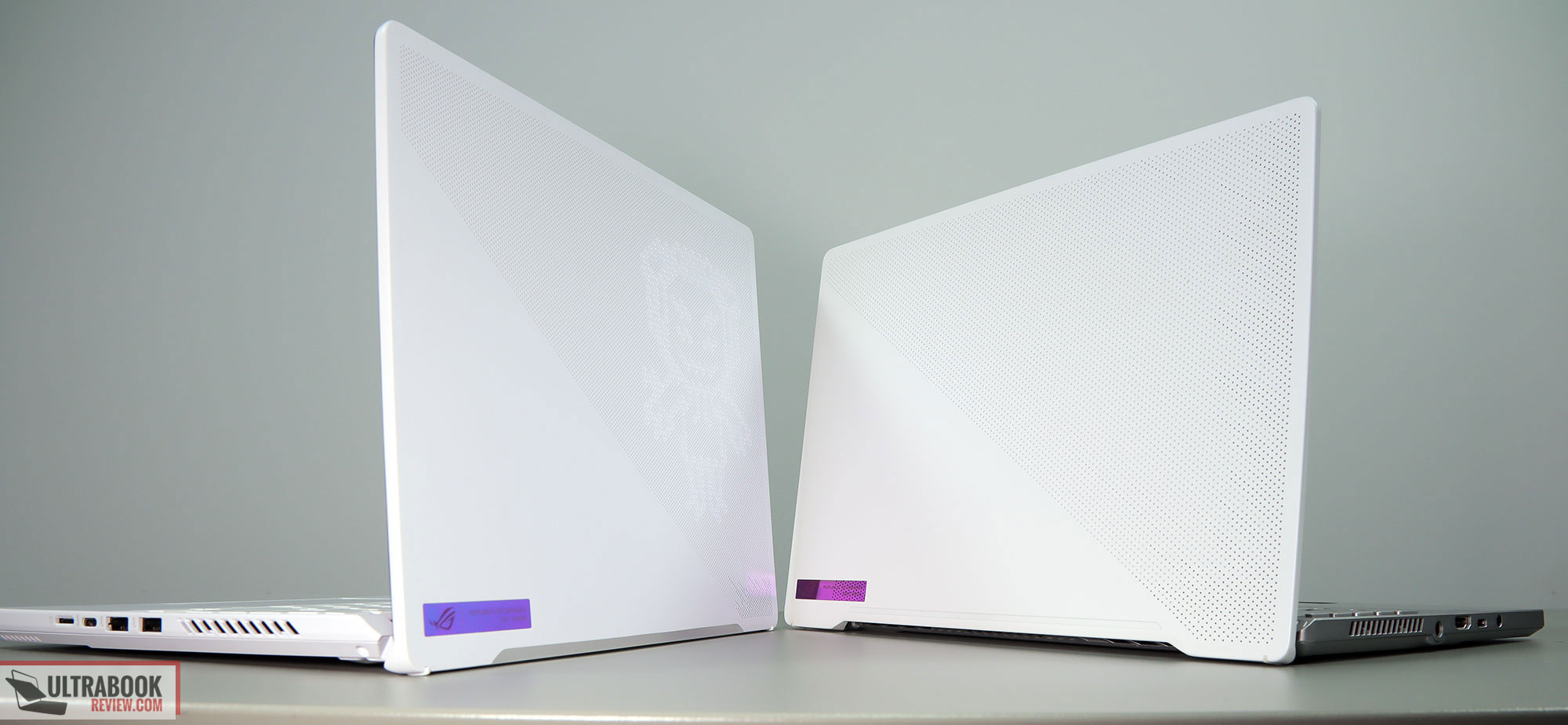
With that in mind, Asus offers these laptops in two color variants, a lighter and a darker one.
We have the lighter variants for the 2022 and the 2021 G14s here, which are quite different. Previously, the G14 was a silver interior with a silver keyboard and a white lid, but with the 2022 model the lid, the interior, and the keyboard are all white, making for a cleaner and more refined design.
The other color variant hasn’t changed, it’s still dark-gray for the lid and interior, and a black keyboard. These are going to show smudges far easier than the white/silver variants, though.
An Anime matrix array of LEDs is optional on all the ROG G14s, with the one of the 2022 models offering an increased number of LEDs, for a denser array capable of displaying more detailed animations and graphics. I never cared much for the Anime array, especially as this adds up to the price and weight of these laptops. They’re also only available on the highest-tier configurations with each generation.

Speaking of weight, that hasn’t changed much over the years, with most models still weighing about 3.65 lbs (1.65 kilos). The overall format has changed with the 2022 lineup, though, as these are now a little narrower, taller, and thinner.
This change allowed Asus to implement a 16:10 display on the 2022 G14s, as well as a larger arm-rest and a much more spacious clickpad. At the same time, the up-firing speakers have been moved at the top of the main deck, so they cannot be easily muffled by your hands anymore, and the keyboard layout is a bit shorter, with a shorter Space key and more cramped arrows. We’ll get to them in a bit.
Another particularity of the 2022 G14s is placed at the top of the screen: a camera, at least, which was missing from the previous models. It’s IR capable with Hello support, but the power button no longer incorporates a finger-sensor as a result, which was available before.
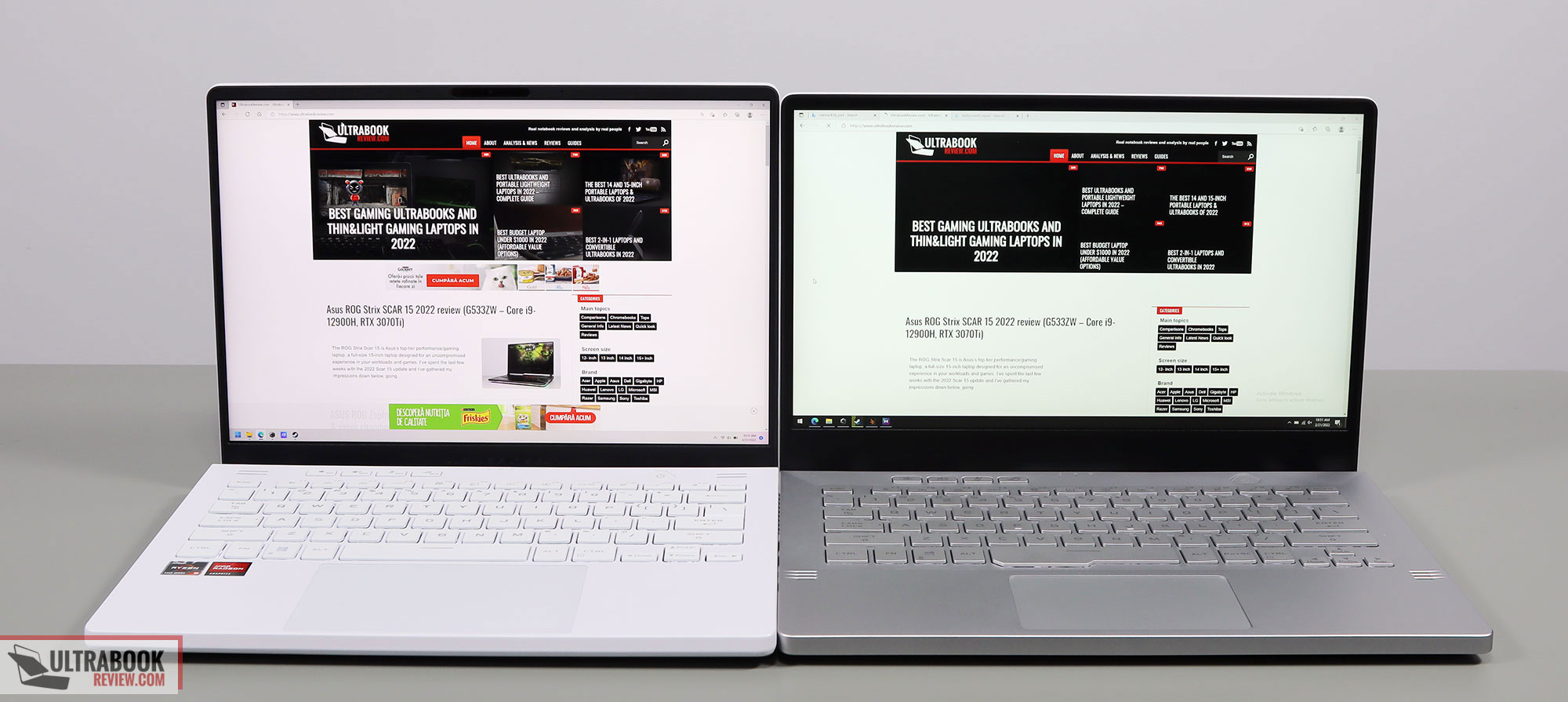
What hasn’t changed between the G14 generations is the ErgoLift hinge design: the laptops’ main body lifts up when you open up the display, allowing for improved airflow underneath, into the fans, and a slightly inclined typing position. However, that also means that the exhausts are placed just under the display, so the hot air blows into the panel. This is more of a concern on the 2022 G14 generation, as this runs hotter internally and places the panel much closer to the radiators, as a result of implementing a taller 16:10 screen with a narrower chin. We’ll further touch on these below.
I do have to mention that Asus have implemented grippier rubber feet on the 2022 G14, a more dulled front lip that’s friendlier on the wrists, as well as the ability to lean back the screen flat to 180-degrees.
One final aspect to mention here is the IO, which Asus have slightly revised over the generations. For the 2022 model, the G14 offers two USB-C ports with either iGPU or dGPU connection, an HDMI port hooked into the dGPU, fast USB-A ports, and a microSD card reader. There’s no longer a security Lock on the left edge, though.
Overall, the 2022 Zephyrus G14 is an ergonomically and aesthetically evolution of the previous generations, but still has some quirks and particularities that are less than ideal for this sort of compact notebook with powerful specs.
Inputs
There are brand new inputs on the 2022 Zephyrus G14, and they’re some of the best you can find on this sort of compact laptop today.
The keyboard is a little shorter than in the past, with narrower arrows and a shorter Space key, but everything else is just right. This layout no longer includes a dedicated key for Print Screen, though, or any extra column of function keys to the right side, like on other 14-inch laptops. There are still the four media keys at the top-left.
The major novelty is the fact that the keys are white on this color variant, making them easy to tell apart with the illumination system switched off, and more readable with the illumination active than on the 2020/2021 G14s, with their silver keyboards. This aspect is further helped out by the fact that the LEDs are RGB, with single-zone control, so that means you can opt for a different backlighting color than white. However, not all G14 keyboards are RGB, as some variants might still ship with a white keyboard instead.
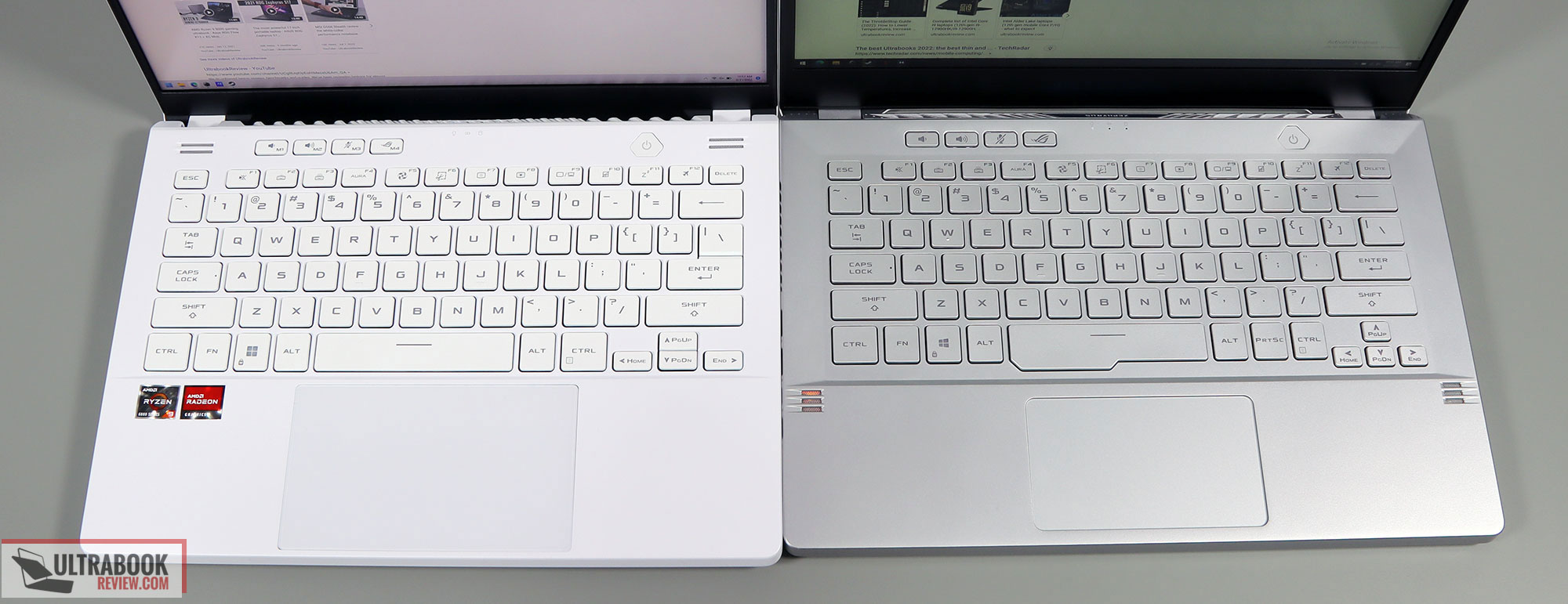
As far as the typing experience goes on this 2022 G14, having both generations side by side I can tell that the keycaps feel a bit rougher to the touch than on the previous generation, and the overall key feedback is a little firmer. At the same time, this keyboard on the 2022 update is noticeably quieter than in the past. Despite all these, though, the typing experience hasn’t changed much, and that’s because the previous G14 was already among the better typers in the ultrabook segment. This new generation is just as good, and quieter.
I also appreciate that the layout offers a dedicated indicator for CapsLock and that you can reactivate the illumination with a gentle swipe over the clickpad once it times out, you don’t necessarily have to press a key to do it.
As for the clickpad, it’s much larger than in the past, thanks to the slightly taller chassis on this 2022 design. This implementation is Precision and made out of glass, and just worked flawlessly during my time with this laptop.
Screens
Asus put a taller 16:10 display on the 2022 Zephyrus G14, with narrower bezels all around and a smaller chin, in comparison to the 16:9 panel in the previous G14 series. That means the available workspace is 10+% larger on the 2022 G14.
They also updated the panels, with options for:
- QHD+ 120Hz 3ms response, 500-nits, 100% DCI-P3, Pantone validated;
- FHD+ 144Hz 3ms response, 400-nits, 100% sRGB, Pantone validated.
Both the FHD and QHD options on this 2022 series are brighter and faster than before, with 3ms response times with Overdrive. That means you’re finally getting rid of the ghosting in fast-paced games that you had to accept with the previous two G14 generations.
Overall, there’s still a difference in overall quality between the QHD+ and the FHD+ options. I’d go with the QHD+ option for those excellent colors and the high brightness if given the choice, even if this is more expensive and takes a toll on the battery life.
For comparison, Asus offered these screens options for the 2021 G14 series:
- QHD 120Hz response, 500-nits, 100% DCI-P3, Pantone validated;
- FHD 144Hz response, 350-nits, 100% sRGB;
- FHD 60Hz response, ~70% sRGB.
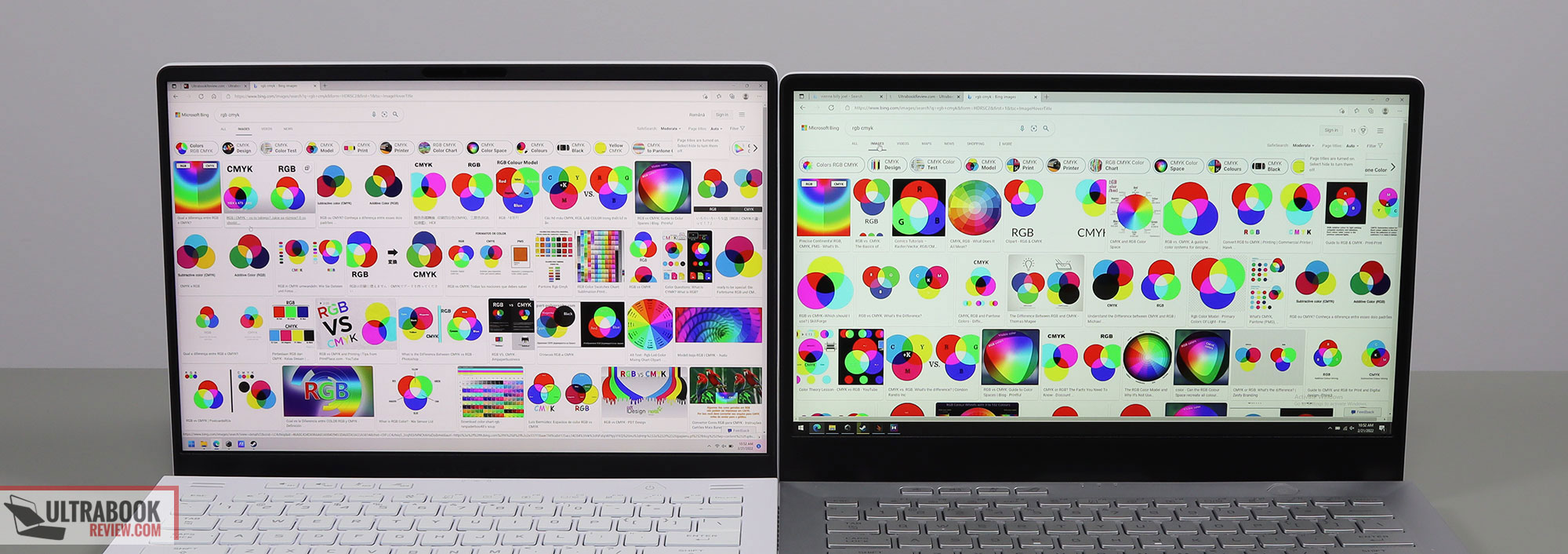
And these three for the original 2020 G14:
- QHD 60Hz, 350-nits, 100% sRGB;
- FHD 120Hz, 300-nits, 100% sRGB;
- FHD 60Hz response, ~70% sRGB.
Hardware and performance
We’re going over four different Zephyrus G14 configurations in this analysis, and I’ve also added links to our reviews for extra details:
Specs-wise, the 2022 G14s are a major revamp of the previous models, as they are built on AMD CPUs and GPUs, with DDR5 memory and PCIe gen4 storage. The CPU and GPU are also running at higher power settings, as a result of a revamped power stage and updated thermal module, with a vapor chamber and higher capacity fans.
Down below we’re going to see how these translate into real-life performance gains.
For starters, here’s how these laptops fare in the Cinebench R15 loop benchmark, which tests the CPU’s performance in sustained demanding loads.
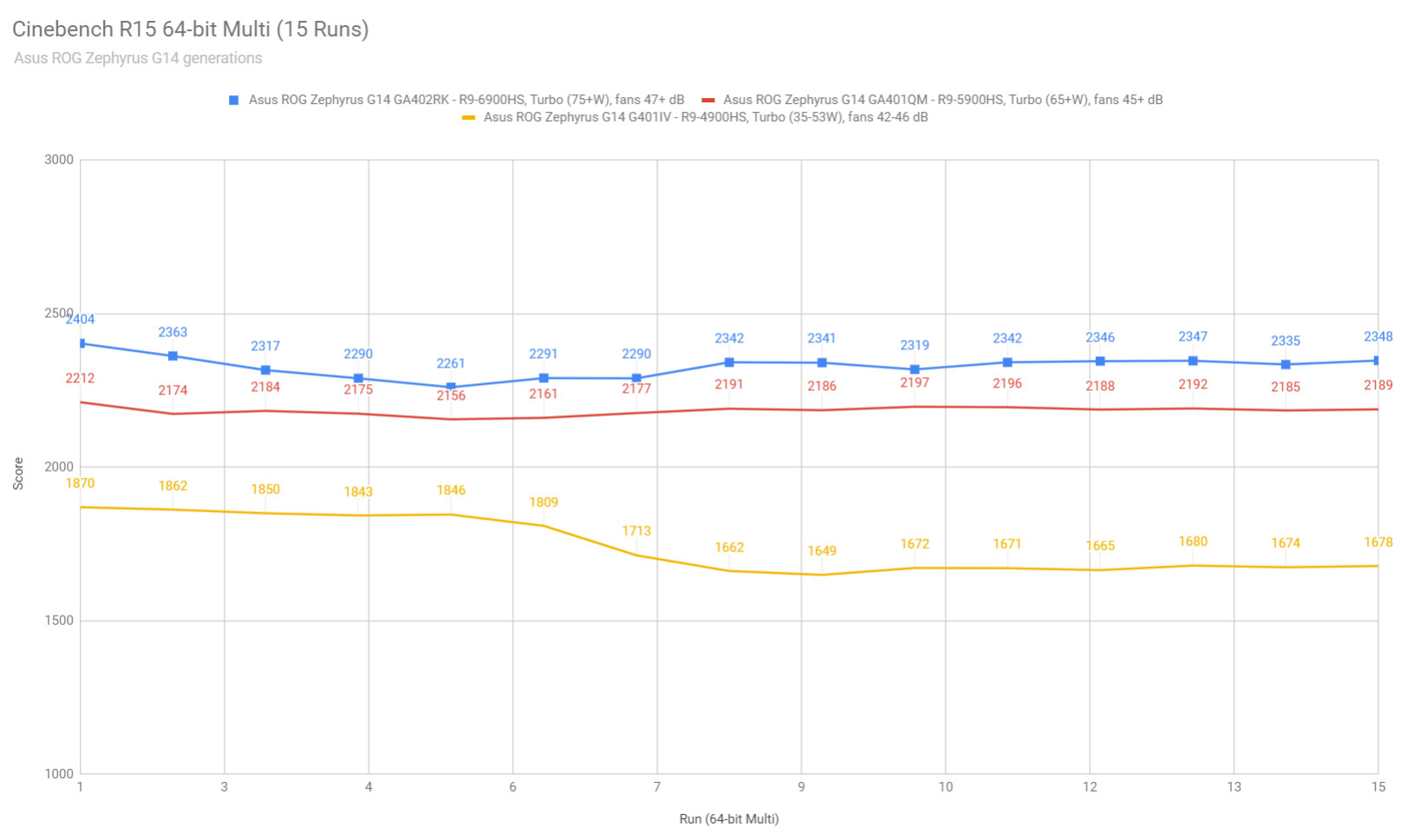
The systems allow for higher sustained CPU power year over year, with an increase in performance, especially vs the 2020 generation. At the same time, all these AMD implementations are running in the 95+ degrees Celsius and are slightly thermally limited as a result. Furthermore, the 2022 generation runs the noisiest of the three.
You’ll find more details on sustained and stress performance for each of these in the reviews.
Next, let’s go over synthetic benchmarks results, on the max-performance Turbo profile and FHD resolution on each laptop.
FHD resolution
2022 ROG Zephyrus G14 GA402RK
R9-6900HS + 6800S 80-105W
2022 ROG Zephyrus G14 GA402RK
R9-6900HS + 6700S 80-100W
2021 ROG Zephyrus G14 GA401QM
R9-5900HS + 3060 60-80W
2021 ROG Zephyrus G14 GA401IV
R9-4900HS + 2060 60-65W
3DMark 13 – Fire Strike
23935 (Graph – 27416, Phy – 25270, Com – 11783)
21187 (Graph – 23796, Phy – 25654)
17390 (Graph – 18974, Phy – 25377, Com – 8458)
14205 (Graph – 15179, Phy – 21546
3DMark 13 – Port Royal
4167
3660
4341
3320
3DMark 13 – Time Spy
9221 (Graphics – 9057, CPU – 10279)
8235 (Graphics – 8033, CPU – 10082)
7627 (Graphics – 7542, CPU – 8150)
6136 (Graphics – 5803, CPU – 9099)
Uniengine Superposition – 1080p Medium
16735
14077
13361
11214
Uniengine Superposition – 1080p Extreme
5122
4296
4638
3499
Handbrake 1.3.1 (4K to 1080p encode):
50.07 average fps
–
45.36 average fps
41.26 average fps
PCMark 10
7496 (E – 10729, P – 9595, DCC – 11102)
–
6781 (E – 10311, P – 9207, DCC – 8913)
5419 (E – 9596, P – 6628, DCC – 6793)
CineBench R15 (best run)
CPU 2404 cb, CPU Single Core 255 cb
CPU 2278 cb, CPU Single Core 248 cb
CPU 2124 cb, CPU Single Core 236 cb
CPU 1903 cb, CPU Single Core 191 cb
CineBench R20 (best run)
CPU 5649 cb, CPU Single Core 615 cb
–
CPU 5061 cb, CPU Single Core 565 cb
CPU 4184 cb, CPU Single Core 478 cb
CineBench R23 (best run)
CPU 14720 cb, CPU Single Core 1576 cb
CPU 13978 cb, CPU Single Core 1551 cb
CPU 12432 cb, CPU Single Core 1432 cb
–
x265 HD Benchmark 64-bit
26.35 fps
–
29.57 fps
32.48 fps
The CPU multi-core performance increases by about 10% between each generation, while the jump in IPC single-core performance is more significant between the original 2020 Renoir-based model and the Cezanne and Rembrandt updates.
On the GPU side, the gains are roughly 15-25% between the RTX 2060 65W in the 2020 G14, the RTX 3060 80W in the 2021 G14, and the RX 6800S 105W in the 2022 G14. They’re made possible by the updated hardware, but also by the increase in power allocations over the years.
Update: For what it’s worth, tech-savvy users have the option to flash a 95W BIOS on the RTX 3060 chip from 2021, improving the performance of that chip by 10-20% between eh different loads, while also increasing internal temperatures. You’ll find details about this on Reddit, but proceed with caution, as this is not an official Asus update and might void your warranty.
For the 2022 generation, the mid-tier 6700S model trades blows with last year’s top RTX 3060 variant, while the new top-tier 6800S model is 5-15% more powerful. The AMD GPU platforms are not as competitive when it comes to Ray-Tracing performance, though, where the 2021 RTX 3060 model is still faster than any of the 2022 Radeon variants.
We then ran some Workstation-related loads on the same profiles and settings. The 2020 G14 is not included in here, as we did not run these tests at that time (and some were not even available back then).
2022 G14 GA402RK
R9-6900HS + 6800S
2022 G14 GA402RJ
R9-6900HS + 6700S
2021 G14 GA401QM
R9-5900HS + 3060
Blender 3.01, Classroom- CPU Compute
6m 25s
–
7m 02s
PugetBench – Adobe After Effects
796
–
612
PugetBench – Adobe Photoshop
1073
–
767
PugetBench – Adobe Premiere
545
–
581
PugetBench – DaVinci Resolve
870
–
880
SPECviewerf 2020 – 3DSMax
76.35
66.60
66.12
SPECviewerf 2020 – Catia
50.73
48.50
43.62
SPECviewerf 2020 – Creo
79.37
75.55
76.67
SPECviewerf 2020 – Energy
27.79
22.55
15.82
SPECviewerf 2020 – Maya
299.15
252.45
201.35
SPECviewerf 2020 – Medical
37.21
35.61
23.64
SPECviewerf 2020 – SNX
77.65
71.70
15.58
SPECviewerf 2020 – SW
135.81
131.60
130.98
When it comes to video editing (Premiere, DaVinci) and some of the GPU-heavier applications (Solidworks), the 2021 RTX 3060 G14 remains highly competitive even against the top-tier 2022 configuration. In combined loads and the CPU-heavier tasks, though, the 2022 generation takes the lead. Up to you to interpret the overall worth of each variant for your specific use cases.
Gaming performance
With these out of the way, let’s go over some games next, at QHD and FHD resolutions.
It’s important to mention that the 2022 G14s offer a MUX and a Discrete GPU mode, while the previous variants only offered a Hybrid mode and no MUX, and that has an impact on the gaming performance, especially at lower resolutions.
That aside, please keep in mind the 16:10 screen aspect ratio on the 2022 G14s, which means they have to display ~10% more pixels than the previous 16:9 options in each case. I also haven’t included QHD results for the 2020 G14, but you can find those in the review, if interested.
2022 G14 – R9 + 6800S
QHD+ Turbo
2021 G14 – R9 + 3060
QHD Turbo
2022 G14 – R9 + 6800S
FHD+ Turbo
2021 G14 – R9 + 3060
FHD Turbo
2020 G14 – R9 + 2060
FHD Turbo
Battlefield V
(DX 12, Ultra Preset, RTX OFF)
87 fps (28 fps – 1% low)
62 fps (48 fps – 1% low)
115 fps (25 fps – 1% low)
84 fps (60 fps – 1% low)
68 fps (46 fps – 1% low)
Cyberpunk 2077
(DX 12, Ultra Preset, RTX OFF)
32 fps (23 fps – 1% low)
26 fps (22 fps – 1% low)
55 fps (39 fps – 1% low)
44 fps (33 fps – 1% low)
–
Doom Eternal
(Vulkan, Ultra Preset)
125 fps (99 fps – 1% low)
–
198 fps (95 fps – 1% low)
–
–
Far Cry 6
(DX 12, Ultra Preset, TAA)
66 fps (57 fps – 1% low)
–
83 fps (64 fps – 1% low)
–
–
Far Cry 5
(DX 11, Ultra Preset, SMAA)
88 fps (67 fps – 1% low)
66 fps (57 fps – 1% low)
101 fps (76 fps – 1% low)
91 fps (58 fps – 1% low)
82 fps (66 fps – 1% low)
Metro Exodus
(DX 12, Ultra Preset, RTX OFF)
52 fps (34 fps – 1% low)
39 fps (24 fps – 1% low)
62 fps (42 fps – 1% low)
46 fps (28 fps – 1% low)
–
Red Dead Redemption 2
(DX 12, Ultra Optimized, TAA)
67 fps (46 fps – 1% low)
56 fps (46 fps – 1% low)
97 fps (66 fps – 1% low)
73 fps (57 fps – 1% low)
61 fps (51 fps – 1% low)
Shadow of Tomb Raider
(DX 12, Highest Preset, TAA)
70 fps (53 fps – 1% low)
50 fps (23 fps – 1% low)
105 fps (78 fps – 1% low)
74 fps (55 fps – 1% low)
72 fps (52 fps – 1% low)
The Witcher 3: Wild Hunt
(DX 11, Ultra Preset, Hairworks On 4)
73 fps (58 fps – 1% low)
63 fps (52 fps – 1% low)
104 fps (75 fps – 1% low)
82 fps (63 fps – 1% low)
74 fps (57 fps – 1% low)
For what is worth, a comparison of the gaming performance of the 2022 Radeon RX 6800S and 6700S configurations is also available here.
Even with the 16:10 displays, the 2022 RX 6800S is a significantly better gamer than the 2021 model at both QHD and FHD tier resolutions.
We’re looking at gains between 15-25% for the RX6800S model vs the RTX 3060 variant, and as much as 40% versus the RTX 2060 G14 from 2020. These gains in framerates are also paired with the faster screen response times with the 2022 G14s, eliminating the ghosting previously noticeable with the 2021/2020 generations.
Now, those above are rasterization tests, and here are some results for RTX titles.
2022 G14 – R9 + 6800S
QHD+ Turbo
2021 G14 – R9 + 3060
QHD Turbo
2022 G14 – R9 + 6800S
FHD+ Turbo
2021 G14 – R9 + 3060
FHD Turbo
2020 G14 – R9 + 2060
FHD Turbo
Battlefield V
(DX 12, Ultra Preset, RTX ON, no DLSS)
25 fps (12 fps – 1% low)
44 fps (34 fps – 1% low)
55 fps (37 fps – 1% low)
58 fps (46 fps – 1% low)
39 fps (28 fps – 1% low)
Cyberpunk 2077
(DX 12, Ultra Preset + RTX, no DLSS)
6 fps (3 fps – 1% low)
–
16 fps (12 fps – 1% low)
–
–
Cyberpunk 2077
(DX 12, Ultra Preset + RTX, DLSS Quality or FSR Balanced)
28 fps (23 fps – 1% low)
30 fps (24 fps – 1% low)
44 fps (35 fps – 1% low)
40 fps (29 fps – 1% low)
–
Far Cry 6
(DX 12, Ultra Preset + DXR reflections / shadows)
52 fps (44 fps – 1% low)
–
65 fps (55 fps – 1% low)
–
–
Far Cry 6
(DX 12, Ultra Preset + DXR reflections / shadows,
FidelityFX CAS and Shading)
52 fps (44 fps – 1% low)
–
65 fps (54 fps – 1% low)
–
–
Doom Eternal
(DX 12, Ultra Preset, RTX ON, no DLSS)
92 fps (51 fps – 1% low)
–
131 fps (69 fps – 1% low)
–
–
Shadow of Tomb Raider
(DX 12, Highest Preset, TAA, RTX Ultra)
29 fps (14 fps – 1% low)
33 fps (17 fps – 1% low)
45 fps (26 fps – 1% low)
46 fps (36 fps – 1% low)
28 fps (18 fps – 1% low)
In this case, the AMD model no longer has the advantage on its side. Activating FSR/DXR when supported helps, but not as much as DLSS does on the Nvidia configurations.
One other aspect I wanted to touch on here is the overall thermals of these three G14 lineups. Here are some average CPU/GPU readings on Turbo, with the laptops sitting on the desk:
- 2022 G14 with RX 6800S 105W – Battlefield V (CPU – 96 C, GPU – 88 C), Far Cry 5 (CPU – 96 C, GPU – 91 C), Witcher 3 (CPU – 84 C, GPU – 82 C);
- 2021 G14 with RTX 3060 80W – Battlefield V (CPU – 95 C, GPU – 80 C), Far Cry 5 (CPU – 96 C, GPU – 87 C), Witcher 3 (CPU – 81 C, GPU – 83 C);
- 2020 G14 with RTX 2060 65W – Battlefield V (CPU – 92 C, GPU – 75 C), Far Cry 5 (CPU – 97 C , GPU – 83 C), Witcher 3 (CPU – 90 C, GPU – 77 C).
With the increase in GPU power, these G14s are running hotter with each generation. That’s even more of a problem on the 2022 model, as the AMD chips are designed to thermally throttle at 95 C, and not at 87 C as the Nvidia chips, which means they can run at higher power and temperatures for longer.
Now, all these temperatures are within the design limits, but heat and electronics don’t usually play well together long-term, and I preffer designs that can keep the internals within 75-85 C on the CPU and at sub 80 C on the GPU for sustained gaming sessions.
There are ways you can improve on these stock temperatures listed above, by bumping the back of these laptops from the desk in order to improve the airflow into the fans, or by opting for manual tweaks in the Armoury Crate software, with an impact on both the performance and the noise levels. You’ll find these explained in the reviews.
I do want to address one more thing here before moving on, and that’s the overall cooling design with the hot air blowing into the screens. Here are the three G14 models during a gaming session, on Turbo.



*Gaming 2020 G14 – Turbo, on desk – playing Far Cry 5 for 30 minutes, fans at 45+dB
*Gaming 2021 G14 – Turbo, on desk – playing Far Cry 5 for 30 minutes, fans at 47+ dB
*Gaming 2022 G14 – Turbo, on desk – playing Witcher 3 for 30 minutes, fans at ~48 dB
With each iteration, these G14s are running warmer and noisier. The keyboard and main-deck areas are within comfortable levels, but the hottest spots are around the radiators and on the bottom of the displays, where the hot air is expelled with this Ergolift hinge design.
For the 2020 and 2021 models, which ran the GPUs at lower temperatures and had that bottom bezel acting as a protective sponge soaking on the heat, the panels only hit temperatures in the low 40s. However, the panel goes in the low and mid-50s with the 2022 generation, as a result of the higher GPU temperatures with the AMD chips, the much smaller bottom bezel, and the way that Asus have redesigned the radiators to only push up the hot air upwards, and not split some of it down and onto the back, as with the previous 2021/2020 designs.
All these are despite the fact that the 2022 G14s implement a much more advanced cooling design than the previous models, with a vapor chamber, higher capacity fans, and liquid metal applied on both the CPU and GPU. I just wonder how this would have coped with a Ryzen 9 6900Hx + an RTX 3070Ti 100W configuration instead…

Battery life
There’s a 76Wh battery in all these Zephyrus G14 laptops, and the runtimes have slightly increased over the years.
Here are our results on the 2022 configuration with the QHD+ screen set at 120-nits:
- 10 W (~7 h of use) – text editing in Google Drive, Silent Mode, screen at 50%, WiFi ON;
- 7.5 W (~9-10 h of use) – 1080p fullscreen video on Youtube in Edge, Silent Mode, screen at 50%, WiFi ON;
- 7 W (10+ h of use) – Netflix fullscreen in Edge, Silent Mode, screen at 50%, WiFi ON;
- 12 W (~5-6 h of use) – browsing in Edge, Silent Mode, screen at 50%, WiFi ON.
In comparison, here’s what we got on last year’s top Ryzen 9 + RTX 3060 + QHD screen Zephyrus G14.
- 11 W (~6+ h of use) – text editing in Google Drive, Silent Mode, screen at 60%, Wi-Fi ON;
- 10 W (~7+ h of use) – 1080p fullscreen video on Youtube in Edge, Silent Mode, screen at 60%, Wi-Fi ON;
- 8.5 W (~8+ h of use) – Netflix fullscreen in Edge, Silent Mode, screen at 60%, Wi-Fi ON;
- 13.5 W (~5+ h of use) – browsing in Edge, Balanced Mode, screen at 60%, Wi-Fi ON.
And here’s what we got with the 2020 variant:
- 11 W (~6+ h of use) – text editing in Google Drive, Silent Mode, screen at 60%, Wi-Fi ON;
- 10 W (~7+ h of use) – 1080p fullscreen video on Youtube in Edge, Silent Mode, screen at 60%, Wi-Fi ON;
- 8.5 W (~8+ h of use) – Netflix fullscreen in Edge, Silent Mode, screen at 60%, Wi-Fi ON;
- 13.5 W (~5+ h of use) – browsing in Edge, Balanced Mode, screen at 60%, Wi-Fi ON.
That aside, keep in mind that the 2020 and 2021 configurations ship with a 180W charger, while the 2022 models ship with a larger and heavier 240W power brick.
All these support USB-C charging as well, up to only 65W on the 2020 model, and 100W on the 2021 and 2022 updates.
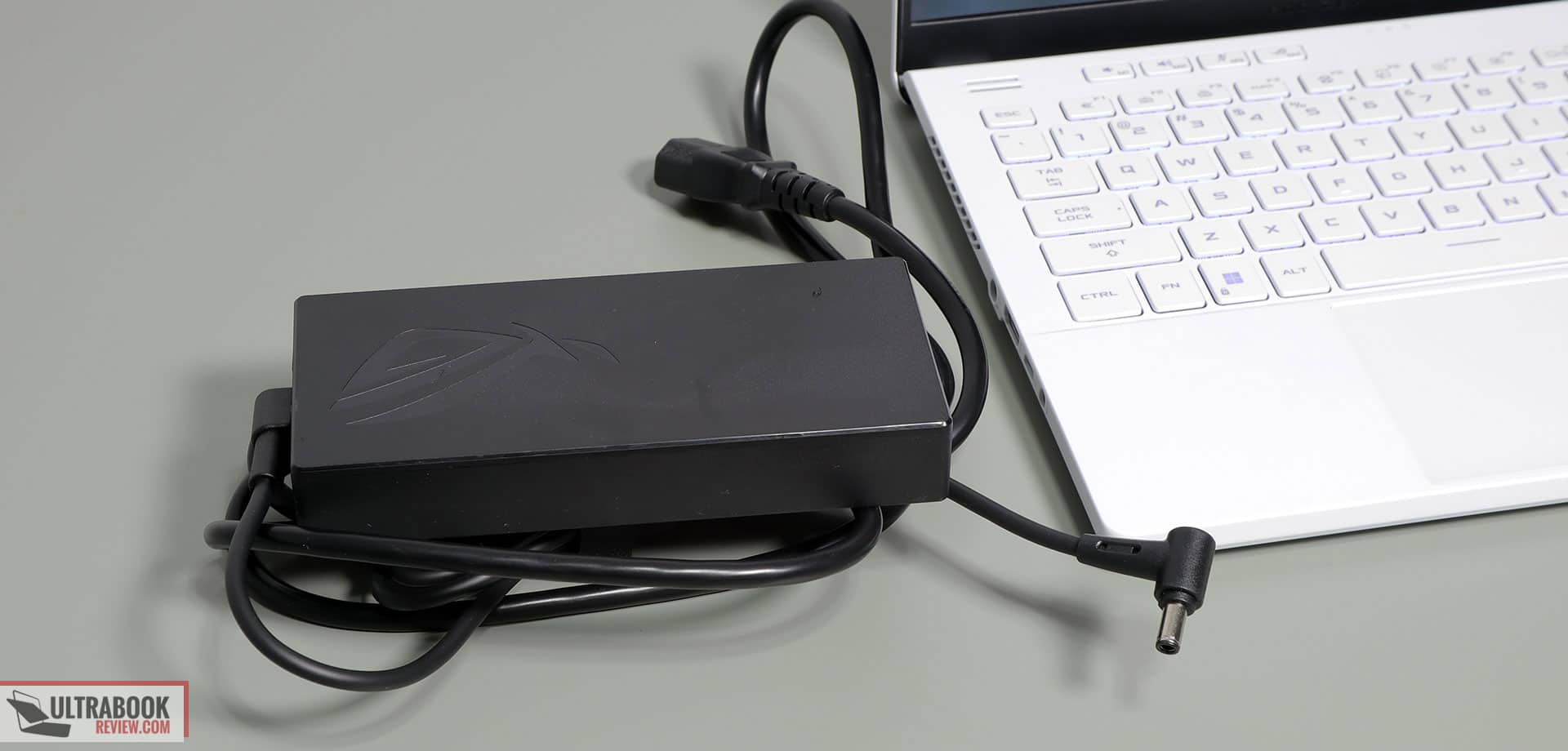
Pricing and availability
The 2021 and 2022 G14 are widely available in stores.
The most recent updates start at around $1500 for the RX 6700S configuration in the US and 1800 EUR here in Europe, while the RX 6800S models are about 200 USD/EUR extra.
At the same time, the 2021 generations are available with discounts, though, with the RTX 3060 model available for as low as 1300 USD/EUR at sales.
Follow this link for updated prices and availability, or this one if you’re in the US and looking for the BestBuy offer, which seem to have some solid exclusive deals for the G14 series these days.
Conclusions
Asus did a lot right with their 2022 iteration of the Zephyrus G14. I appreciate the refined aesthetics and ergonomics, the 16:10 displays with excellent panel options, the updated inputs, and the faster and more efficient hardware, on top of everything else that they were already doing right with the previous variants of this lineup.
These do come with a significant price increase over the 2021 versions, though, especially with these available on sale all over the world now.
I’m also not entirely sold on the whole idea of allowing the hardware to run at higher temperatures in this design, which leads to higher internal and external temperatures than before, especially on the bottom panel that’s now placed right next to the exhaust. Sure, the 2022 G14 is significantly faster than the 2021 model, especially in GPU loads, but I can’t stop wondering how these high internal and screen temperatures will impact the long-term reliability several years down the road.
Given these aspects and the overall price-competitiveness of the 2021 G14 configurations, I find the previous generation to still be a very competitive option at this point, and something you should still consider while still available.
Later on, the 2022 models are going to get a price cut as well, and hopefully, Asus will be able to tweak the thermals with later software updates that would somewhat mitigate our findings so far. At that point, I’d lean more towards the 2022 G14, which I really like as a compact all-purpose computer, even if not entirely sold on how Asus put up all the pieces together here.
Anyway, that’s about it for this Zephyrus G14 comparison. You’ve read my impressions, and now I’m looking forward to hearing your thoughts on these three as well, so get in touch down below.

Disclaimer: Our content is reader-supported. If you buy through some of the links on our site, we may earn a commission.
Navigation: Ultrabookreview.com » 14 inch
Our content is reader-supported. If you buy through some of the links on our site, we may earn a commission. Terms






